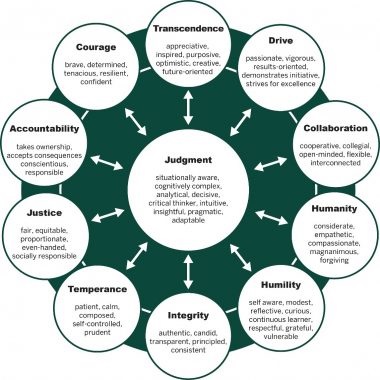Leadership Involves Character
Introduction
"...every man......is the creature of the age in which he lives. Very few are able to raise themselves above the ideas of their times..."
Voltaire (1694-1778) as quoted by Mary Crossan et al, 2018
Character is an important part of leadership, ie strength of character. In the turbulent times around technological changes, pandemic, challenges, etc; leadership propelled by strong character is required. Character can be developed, ie it is like a muscle as it needs to be exercised regularly and if is not it can degenerate. Conversely, the more you use it, the stronger it becomes. Anything that helps people become more self-aware, like reflection, is important in developing character. As there is a time delay between stimulus and response, we can control or choose our response. Too often this is dominated by fear, caution and denial. However,
"...to train people to stay sharp, connected and in the moment, while challenging them to exercise all the dimensions of character outside their personal comfort zone..."
Mary Crossan et al, 2018
This is a constant challenge.
Linked with character are competence and commitment.
There are 11 connected dimensions of character, ie:
i) judgement
ii) transcendence
iii) drive
iv) collaboration
v) humanity
vi) humility
vii) integrity
viii) temperance
ix) justice
x) accountability
xi) courage
(see below diagram for more detail on each dimension).
Dimensions of leadership's character

(source: https://iveybusinessjournal.com/taking-leadership-from-good-to-great/)
The key one is judgement, with the other 10 dimensions feeding into it. Sometimes sound judgement is called 'practical wisdom'.
You need to get the balance right with the dimensions. For example, if you have plenty of drive and courage but are weak on humility and accountability, there is a high risk of reckless behaviour. Similarly, integrity without humility leads to arrogance; collaboration without courage fosters group-speak; integrity, authenticity and candour need to be supported by humility and humanity.
"...developing character is different from developing competencies..."
Mary Crossan et al, 2018
Change involves judgement. This is most obvious in the selection of staff, frameworks, techniques, tools, activities, etc. Generally, judgement is improved when based on experience.
To develop character, we need to reflect upon our thoughts, words and actions. It is not simply about accumulating knowledge and experience as in acquiring a competency.
"...It is about discovering, adapting, adjusting and reconciling aspects of who we are, why we are that way, and who we want to become......developing leader character requires exercising self-awareness (a key behaviour associated with humility) which starts with a critical look at our strengths and weaknesses. Activating leader character occurs when we work to strengthen our character by balancing dimensions and cultivate an awareness of situations that activate or deactivate them. Sustaining strength of leader character mean that our balance holds across contexts and under stress..."
Mary Crossan et al, 2018
You need to understand the forces that could impact on these dimensions of leadership. For example, the bystander effect, ie the diffusion of responsibility tends to increase with group size.
"...In other words, the larger the number of witnesses to some form of injustice, the less likely it becomes that an individual bystander will decide to proactively aid the victim. Reason for this can range from self-serving assumptions that others are more qualified to help to self-serving assumptions that others have greater responsibility to help..."
Mary Crossan et al, 2018
In other words, bystander impact influences behaviour where people can hide in crowd. This is linked to fear tied to weakness in humility, courage, humanity and accountability.
Another driver is social comparison that makes it difficult for people to deviate from the current norm, ie they tend to do what others are doing. This is similar to peer-group pressure.
"...fear of being judged as different prevents us from making character-based judgements..."
Mary Crossan et al, 2018
Showing great leadership is not easy as it is
"...hard to routinely put yourself at risk by championing change, proposing an alternative action, calling out unprofessionalism, or speaking up against poor decision-making, especially when no one else is willing to join your cause..."
Mary Crossan et al, 2018
Discovering, activating, strengthening, connecting, and sustaining character

(source: https://iveybusinessjournal.com/taking-leadership-from-good-to-great/)
Remember:
"...organisational culture is largely a reflection of the character of its leaders. For better or worse, character is contagious. And because character begets character, developing strength of character at the top can impact across all levels because of a truly high-performing leader sets the tone of a high-performing organisation..."
Mary Crossan et al, 2018
Developing the dimensions of a great leader's character is a never-ending job.
Character defines how we act and react, and it is a choice. It involves allowing yourself to be vulnerable, setting ego aside so that you can do authentic reflection about current performanThisce to form a basis for improving tomorrow.
"...You cannot dream yourself into a character, you must hammer and forge yourself one..."
Henry David Thoreau as quoted by Mary Crossan et al, 2018
